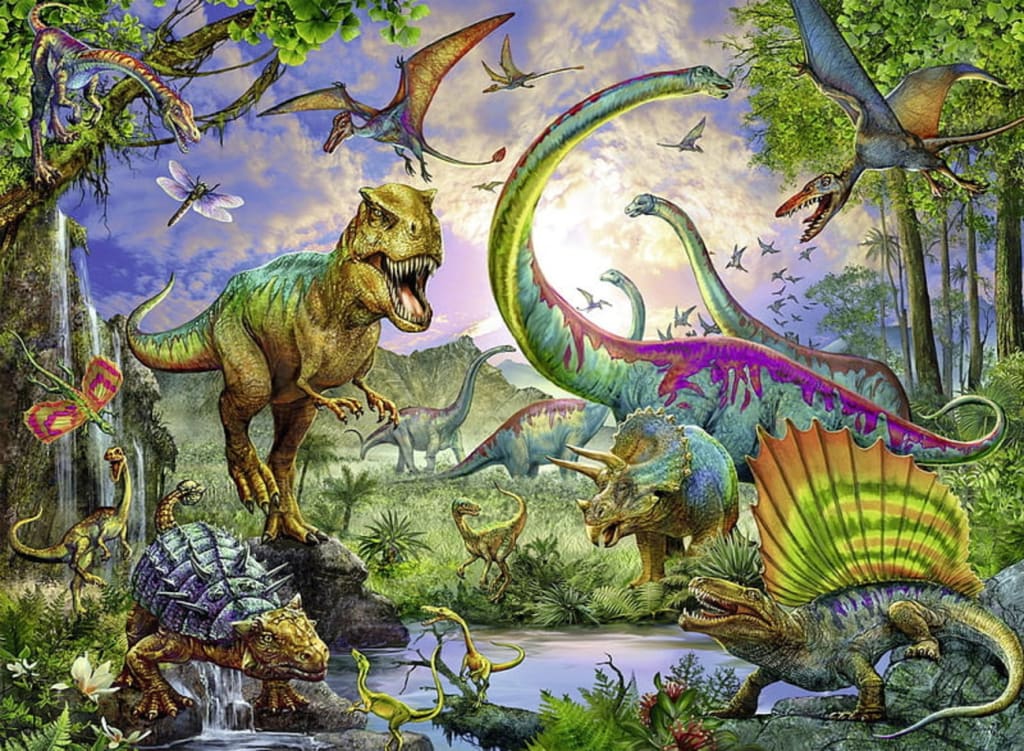
From the Late Triassic period (approximately 230 million years ago) to the end of the Cretaceous period (about 65 million years ago), dinosaurs—a diverse group of reptiles—dominated the Earth for almost 160 million years. There are various discrete eras in the history of dinosaurs:
Time Period of the Triassic (230–200 million years ago):
Dinosaurs descended from older archosaurs, a group of reptiles that also included crocodiles and birds, and first appeared in the Late Triassic.
Early dinosaurs had two legs and were comparatively small. They lived side by side with tiny mammals and other reptiles.
Between 200 and 145 million years ago, during the Jurassic Period:
The Jurassic Period saw a major radiation and diversification of dinosaurs.
During this period, some of the most famous dinosaurs ever existed, including the theropods (bipedal carnivores) like Allosaurus and Dilophosaurus and the sauropods (long-necked herbivores) like Brachiosaurus and Apatosaurus.
From tiny, feathered dinosaurs, the earliest birds also appeared during the Jurassic–Cretaceous Period (about 145–65 million years ago):
Dinosaurs continued to diversify during this time, giving rise to formidable carnivores like Tyrannosaurus rex and massive herbivorous dinosaurs like Ankylosaurus and Triceratops.
There was a typically warm temperature, and the continents remained in their original positions from today.
The expansion of flowering plants had an impact on the evolution of herbivorous dinosaurs.
The end of the Cretaceous period, roughly 65 million years ago:
The mass extinction of dinosaurs at the end of the Cretaceous epoch is the most well-known event in dinosaur history.
It's thought that a significant asteroid impact, combined with volcanic activity and other environmental modifications, is what caused extensive biological devastation.
The Mesozoic Era came to an end at this event, and the Cenozoic Era began, with the extinction of numerous dinosaur species and other organisms.
The Post-Cretaceous Period, which spans 65 million years, includes:
Mammals were able to evolve and eventually take over as the main terrestrial vertebrates after the extinction of the non-avian dinosaurs.
Birds are still alive today because they survived the extinction of the little theropod dinosaurs from which they descended.
Scientists are able to study and reconstruct the history, anatomy, and behavior of dinosaurs thanks to the rich fossil record that these animals left behind. The study of dinosaurs has made a significant contribution to our knowledge of Earth's history and evolution.
Dinosaurs lived for a wide duration of Earth's history, extending over 160 million years from the Late Triassic to the end of the Cretaceous epoch. Dinosaurs underwent a period of rapid evolution, giving rise to a broad array of species that differed greatly in terms of size, structure, and behavior. The following are some significant facets of dinosaur life:
Diversity: The group of reptiles known as dinosaurs was incredibly diverse. They ranged widely in size from tiny, feathery dinosaurs the size of chickens to massive sauropods like Argentinosaurus, which reached lengths of over 100 feet. They comprised both herbivorous and carnivorous species.
Habitats: Dinosaurs lived in a variety of settings, including dry deserts, marshes, and lush forests. Various species have evolved to fill various ecological niches. While some dinosaurs were designed to live in deep forests or along the shore, others were better suited for life on wide plains.
Dinosaurs have a variety of feeding practices. While carnivorous dinosaurs like Tyrannosaurus rex and Velociraptor were predators, herbivorous dinosaurs like Triceratops and Stegosaurus fed on plants. A few dinosaurs had a more diversified diet than others, such as the omnivorous Ornithomimus.
Social Behavior: Based on available data, several dinosaur species may have been gregarious creatures who lived in families or herds. Certain dinosaur species' social systems can be inferred from fossilized trackways and bone beds that contain several members of the same species.
Reproduction: Dinosaurs had a variety of reproductive techniques. There is evidence that some dinosaurs, such as the huge sauropods, cared for their eggs and possibly the hatchlings that they laid. It's possible that other dinosaurs used various reproductive techniques, however it's frequently difficult to infer specifics from the fossil record.
Extinction Event: The mass extinction of dinosaurs approximately 65 million years ago at the end of the Cretaceous epoch was the most important event in the life of a dinosaur. Widespread extinction was caused by a number of events, including an impact from an asteroid, volcanic activity, and environmental changes. Numerous organisms, including many dinosaur species, were not spared from this catastrophe.
Evolution of Birds: Some small, feathered dinosaurs survived the cataclysmic extinction that wiped out most dinosaur species, and they eventually evolved into birds. Theropod dinosaurs are thought to have left behind only one lineage of extant dinosaurs, birds.
Paleontologists can gain important insights into the biology, ecology, and evolution of these amazing extinct animals by studying dinosaur remains, trackways, and other evidence.






Comments
There are no comments for this story
Be the first to respond and start the conversation.